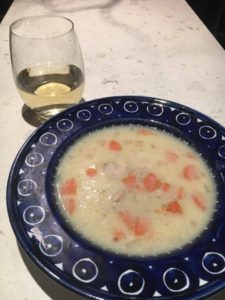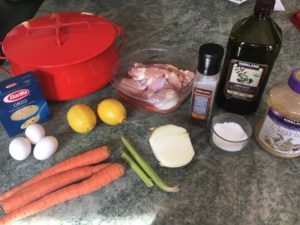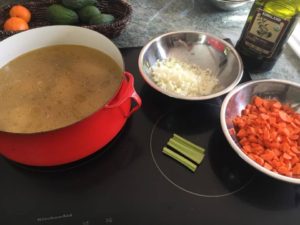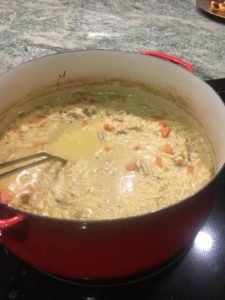Avgolemono soup

When I was younger I remember going over to my grandparent’s house every easter and after we hunted for eggs and found the chocolate bunnies we would sit down for a meal around lunchtime and eat a variety of foods. There was always one dish that constantly found itself on the table, a foamy soup. It was lemony, had chunks of chicken and carrot in the broth with little rice like noodles, they would call it Avgolemono. I never really thought about it, but I enjoyed saying the name, Avgolemono. It literally meant egg and lemon in greek. My mother explained to me and my siblings that this was a traditional Greek dish and further explained her half Greek heritage. The Greek side of my family had this tradition of roasted lamb and other greek dishes for easter, but the avgolemono soup was the only thing my Papu loved (Pa-poo or the full greek Pappous or Papouli which meant grandfather), so every year it was served. My Pappo was full Greek and he loved avgolemono soup so it was the only dish he could ever make. Unfortunately he hardly ever cooked, being raised in a time when only with women cooked and men were in charged of the grill. In my whole life I only remember eating the soup he made twice. After he died and I was a little older I began to remember the soup and looked for it every time we had gone out to dinner. Unfortunately, most, if not all restaurants served a version that was sweeter and more creamy than foamy. This kind was good but it was not the traditional dish I remembered.
Avgolemono soup is a Greco-Turkish-Arab dish that was spread mainly by Sephardic Jews, who supposedly brought lemons from Southern Europe to Italy then to Greece in about the early 1000 A.D. Avgolemono soup is best known for being a Greek dish, but it is mostly known in the United States as a creamy soup. Avgolemono soup is part of the Mediterranean diet, the best way of eating food. After traveling to so many countries and states I must say that Mediterranean food is one of the best kinds of diets I have ever eaten. I visited family in Greece and I never felt disgusted or oily after a meal. Kind of like when you eat a huge meal and an hour later you still feel heavy with processed oil, that is not the case with Greek food. After eating in Greece I always felt refreshed and full at the same time, also we got to drink wine with almost every meal. It was this kind of diet that made me feel that I had energy. This is because of the amount of healthful fresh ingredients and the lack of processed foods and sugar. If any foods call for sweetness then they utilize honey with its natural sweetness. It is only the Americanized versions of Mediterranean food that use processed food, just as a note Pizza is not part of the Mediterranean diet no matter what anyone says, sorry. But Mediterranean food is so easy to make, one does not have to go out to get Mediterranean flavors. Avgolemono soup is no exception.
The ingredients for Avgolemono soup are lemons, orzo, egg, onion, chicken, water, carrots, celery, olive oil, garlic, and salt and pepper. Orzo is a pasta that looks like small pellets. Orzo is a word that other countries associate with rice, but in Italian it means barley and in Greek it is called “kritharáki” meaning little barley. It is orzo, chicken and the lemon egg that make up the thick meaty goodness of the soup. Traditional avgolemono soup is made with egg that has been whipped into a stiff foam much like meringue, which is then incorporated into a chicken broth with lemon. Lemons, the second component of the dish, are suggested to originate from North East India. These two ingredients combine to create a favorite aspect to most Greek dishes, the lemon sauce.
Avgolemono comes from the greek word αυγολέμονο. Originally it was a lemon sauce that was put on most dishes, but it is especially delicious when made into a chicken soup. This dish is most well known for being from Greece because of the increase in American cookbooks that try to include cultural dishes. It is often represented as a creamy soup, not the foamy chicken soup that is served traditionally. It could be argued that this American type of representation of avgolemono soup is one of ignorance of other cultures, but both recipes are delicious.
I am providing both recipes so that you may sample each, or you could make the traditional then go out and buy the Americanized version. Also you can use rice instead of orzo, but it will never be the same. Also for the American version it is common to add corn starch if you want thickness, but normally the egg gives it the thickness the soup needs.
Ingredients
Chicken: no skin. It can be thighs or breasts,(Whatever you prefer, I like the thighs because of the darker meat) For this recipe I used 8 thighs.
1 white onion, diced into little cubes
Olive oil, the best oil
Minced garlic, about a heaping tablespoons worth
Carrots: cut into cubes or chunks, just so they are bite sized
1 celery stalk (just enough to flavor the broth)
1 ½ gallons of Water
4-5 eggs depending on how much broth is made.
2-3 lemons
Orzo: a rice sized pasta, (Warning they absorb a lot of liquid), you will need about 1 cup or less.
Salt and pepper to taste.

Instructions
Broth: 1 1/2 hours
Broth can be made several ways, with bullion, or with traditional ingredients. I choose the traditional ingredients. First, in a large pot, about two gallon size, pour about two tablespoons of olive oil. Then take your chicken, and massage garlic, salt and pepper into the flesh. Then turn on the stove to medium high and heat the oil. When the oil begins to get more runny, spread the oil around the base of the pot, then gently place the chicken on the bottom of the pot. Turn the heat down to medium heat. You are not cooking the chicken all the way, you are just searing the meat. Flip the chicken to sear both sides and so that the meat is partly cooked. Remove the chicken and pour in a gallon and a half of water, or as I do, put enough water in the pot so that it is about three inches from the rim. Turn on the heat and put in the carrots, onions, and the celery.

Take your chicken and cut the meat into cubes and off the bone and set aside for later. Take the bones and put them in the pot so that they can cook and release the chicken flavors. Heat the broth so that it reaches a rolling boil. As it reaches the boil, turn the heat down to a simmer and let sit for about an hour and a half, just so the flavors can really come out of the bones and vegetables. Skim any fat from the surface, and at this point you can either save the broth for later or go right to the soup.
I personally do not care for bullion because it is made from manufactured flavors, but if you are in a rush it works. For bullion, most packages have instructions on the label, but here is the general idea of what to do. Put water in the pot and heat. Make sure to measure out the correct amount so that the bullion can be measured. Heat water to boil then add instructed bouillon powder or paste. Stir to incorporate and let simmer for a few minutes. You let it simmer so that the flavor can really come out of the bullion. After that it is ready to move on to the next step.
The Soup, traditional greek way:
So you have your broth, the fat skimmed off the top, celery and bones removed. The carrot remains in the broth. Bring the broth to a boil and add the orzo and the diced chicken. Bring the the heat down to a simmer and take out your eggs. Separate the egg whites from yolks. Save both. WIth the egg whites you want to whip them into a stiff foam. You can use the whisk settings on a mixer if you have that available. The egg yolks are to be mixed and set aside. Now take one lemon and cut it in half. Squeeze one half into the soup and mix in. As the orzo finishes cooking, squeeze the rest of the lemon into the egg yolks. Whisk the egg and lemon together so that it is well incorporated. By this time the egg whites should be stiff. Slowly fold the egg whites in with the egg yolks. Continuously stir the egg so that it does not curdle with the acid from the lemon, but try to keep the foaminess of the egg. Next, slowly temper the egg. To do this take a spoonful of broth and gently pour into bowl with egg. Gently whisk together as you continually incorporate spoonfuls of broth until the egg is about as hot as the broth. Next add salt and pepper to the soup to taste. Then slowly pour into soup, as the orzo should be cooked completely. Stir gently to spread the creamy foam throughout the soup and serve immediately. If the rest of your meal is not ready do not add the egg and remove the soup from the heat or else it will end up being a creamy noodle dish.
The soup: American easy version
Again, you have your broth and have brought it to a boil. Add the uncooked orzo and the chicken. In a separate bowl put the eggs and whisk together, adding the juice from two squeezed lemons. For thickness, create a cornstarch mixture with a little of the broth. About two teaspoons worth of cornstarch whisked into a small cup of hot broth. It needs to be hot in order for the powder to break down and dissolve easily. When the orzo is almost done put the egg and cornstarch into the soup and stir until thick and orzo is done cooking. Add salt and pepper to taste. Serve at any time, just be cautious that orzo likes to absorb the broth.
There you have it, Avgolemono soup. It pairs well with some greek salad of cucumbers, tomatoes, feta cheese with olive oil and red wine vinegar or balsamic vinegar, garnished with basil. Then drink a glass of wine and for dessert have a glass of Mavrodaphne. Cheers or Yammas!

References
Adcox, Susan. “All About Greek Grandfathers.” About.com Parenting. N.p., 2016. Web. 13 Dec.
2016. http://grandparents.about.com/od/Grandparent-Names/g/Greek-Name- For-Grandfather.htm
“Avgolemono.” Wikipedia. Wikimedia Foundation, n.d. Web. 13 Dec. 2016, from
https://en.wikipedia.org/wiki/Avgolemono
Benayon, M. “Avgolemono Soup – Traditional Greek Recipe | 196 Flavors.” 196 Flavors. N.p., 22
Jan. 2016. Web. http://www.196flavors.com/2016/01/22/greece-avgolemono-soup/
“How to Follow the Mediterranean Diet | Health | Patient.” Patient. N.p., n.d. Web. 13 Dec. 2016.
http://patient.info/health/mediterranean-diet
“Lemon.” Wikipedia. Wikimedia Foundation, n.d. Web. 13 Dec. 2016., from
https://en.wikipedia.org/wiki/Lemon
“Mavrodafni.” Wikipedia. Wikimedia Foundation, n.d. Web. 13 Dec. 2016.
https://en.wikipedia.org/wiki/Mavrodafni
Olver, Lynne. “The Food Timeline: History Notes–soup.” The Food Timeline: History Notes–soup.
N.p., n.d. Web. 13 Dec. 2016., from http://www.foodtimeline.org/foodsoups.html
“Orzo (pasta).” Wikipedia. Wikimedia Foundation, n.d. Web. 13 Dec. 2016.
https://en.wikipedia.org/wiki/Orzo_(pasta)
“Sephardi Jews.” Wikipedia. Wikimedia Foundation, n.d. Web. 13 Dec. 2016., from
https://en.wikipedia.org/wiki/Sephardi_Jews
Zgourides, C. “Inviting Writing: The Secret of Lemon Soup.” Smithsonian.com. Smithsonian Institution,
Mar. 2011. Web.from http://www.smithsonianmag.com/arts-culture/inviting-writing-
the-secret-of-lemon-soup-30492851/
Photos By Emily Hartman

Hi Emily, Your avgolemono soup was scrumptious, yum! I’m going to look into that Greek restaurant you mentioned that has this soup on their menu in Long Beach. I agree with you that Mediterranean food is much healthier than most of the American diet. Take out the processed in processed foods and you have Kosher foods; foods that are natural and properly prepared, which I try to consume as much as possible in my diet.
Thanks for sharing the recipe.
Carol